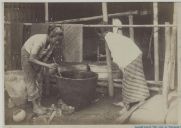Indigo
This third cloth shows the next stage in the production process, but also skips a few steps. According to the inventory card this cloth has been dyed dark blue with indigo, a natural blue dye. The cloth would need multiple dips in a dyebath of indigo, sometimes up to 7 times, in order to obtain this deep dark color.
The wax was removed after dyeing. How this was done exactly is not known or mentioned. It was customary to remove the wax with boiling water, which the people on Java called ‘lorod’. The batik is completely submerged in the water, which was sometimes mixed with something to get the wax off the cotton more easily. The parts that were covered with wax before have kept their original color, in this case white, while the other parts have turned blue because of the dye.
The wax could also be removed by scraping it off. The wax, which has turned soft after multiple rounds of dyeing, can be scraped off while the cloth is stretched. With this method, however, not all the wax is removed from the fabric, only the wax that covers the surface of the cloth. The residual wax prevents the dye from properly imbuing the fabric, which results in an effect described as “sun through the leaves”. This special effect is still regularly seen on batiks from Yogyakarta and Solo. We cannot deduce from the sixth and last cloth whether this effect was intended or not, but it seems clear that the wax has not been boiled out properly.


